
La Mer Shields
The convex ceramic of La Mer plays on the idea of a shield, defined as a person or thing providing protection from harm. It also heralds honor of and sense of family like the countless species with which we share this planet. The ceramic shields intend to uplift wonder and awareness encouraging wise, sustainable investments.
La Mer a tributary of the Wildlife work, explores life of the ocean from the bioluminescent creatures of the abyss to the exquisite and mighty microscopic beauties in the sunlit zone. These single-cells photosynthesize more than half of Earth’s oxygen sustaining all life as the base of our food chain and ecosystem. Many cells form colonies networking to empower their oxygen prowess and mutual support.
The intricate ceramic forms shine light on the wonder as well as the delicate, diverse and mostly unseen, little known life of the sea with which our lives are intrinsically linked. The quiet white of the series offers the spotlight to the complex sculpture.

Conservare - Marine Diatom Arachnoidiscus Shield, La Mer
ceramic, 13.5” h x 13.5”w x 2.5”d
Latin root of conserve: con=together + servare=to keep: Protect (something especially environmentally or culturally important, a place or thing) from harm.

This is a microscopic photo of the actual mind blowing Diatom Arachnoidiscus, my inspiration in glass lace.

Diatoms are one-cell organisms living in fresh and salt water and the moisture in the soil. Their exquisite silica shells house phytoplankton. The holes or areolae of their glass lace take nourishment in and engineer filtering and buoyancy.

Diatoms work together in colonies and are responsible for photosynthesizing over 25% of Earth’s oxygen earning the title, Lungs of the Planet. A beautiful and powerful model for how we can move forward during this time of transition, individually and collectively.

They continue profound service after life as their fossils provide micro-paleontologist climate history past, present and future and more.

Being a ceramicist offers an intimate connection for the brick of my kiln is made from the remains of ancient diatoms gathered from the ocean floor as diatomaceous earth. The silica structure of the diatom is the same material in my glazes and clay body particulates. This micro-organism not only provides oxygen for our planet, it makes this ceramicist’s artistic breath and process possible.
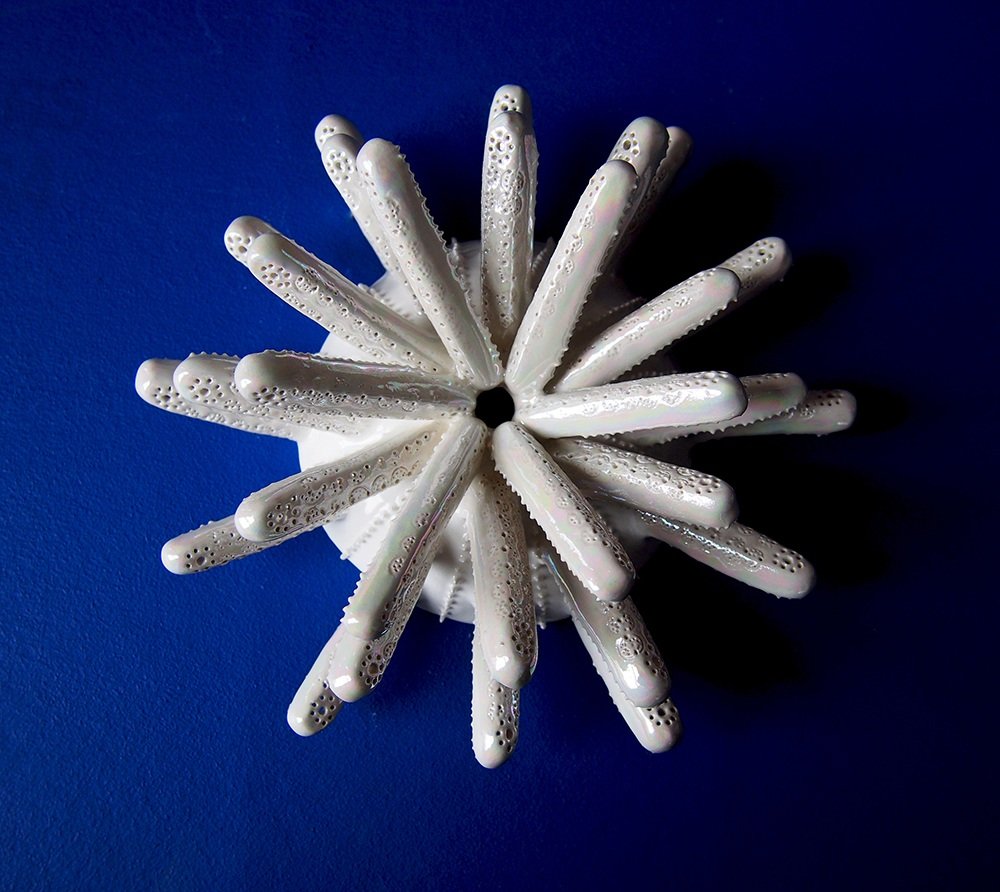
Stellate Diatom Thalassionema Colony Shield
hand-built ceramic, 8”h x 8”w x 4”
Marine single-cell silica structure housing plankton forms starshaped colonies. This pennate type of diatom connects by producing cushions at points of contact that fuse the individuals into strands or complex star formations like this sculpture. The separate uni-cell diatoms come together for mutual benefit and empower their nutrient and oxygen production.
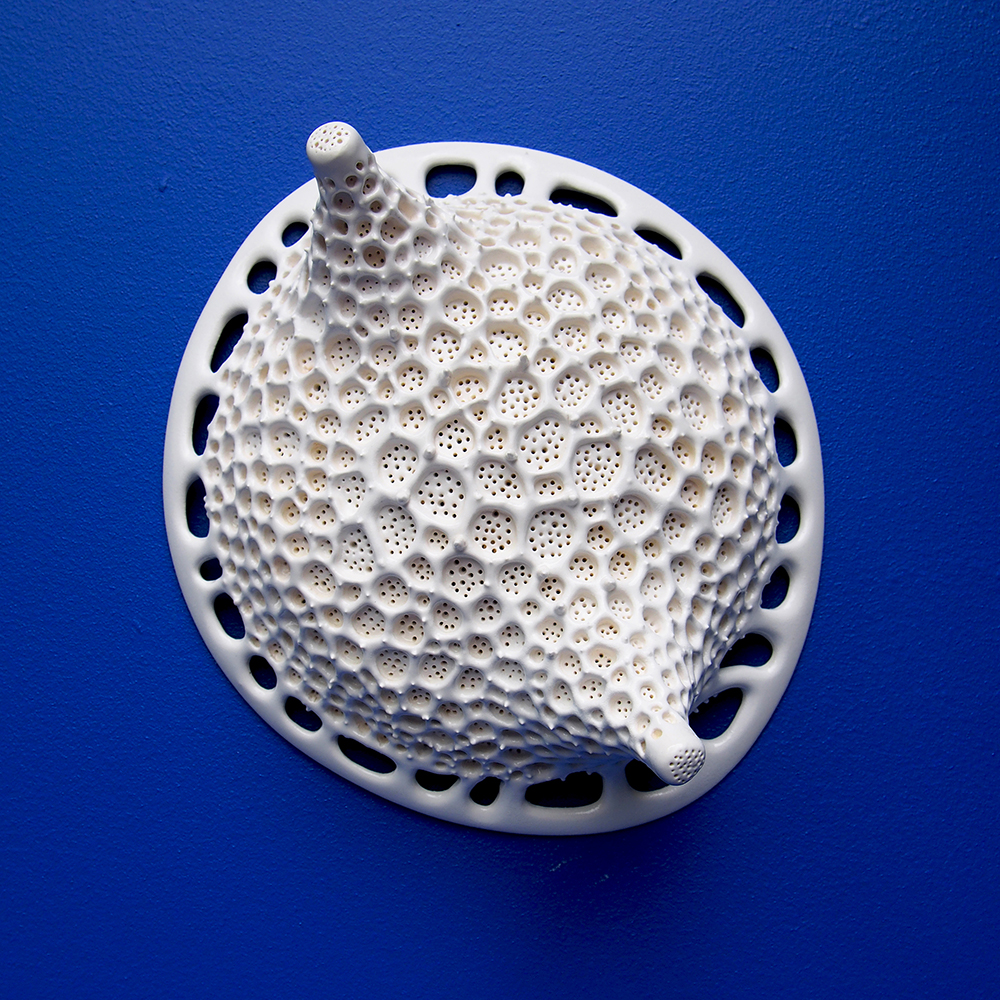
Diatom Odontella Shield
hand-built ceramic, 9” x 12” x 4”
More info on this species under Diatom Odontella Petit Shield.
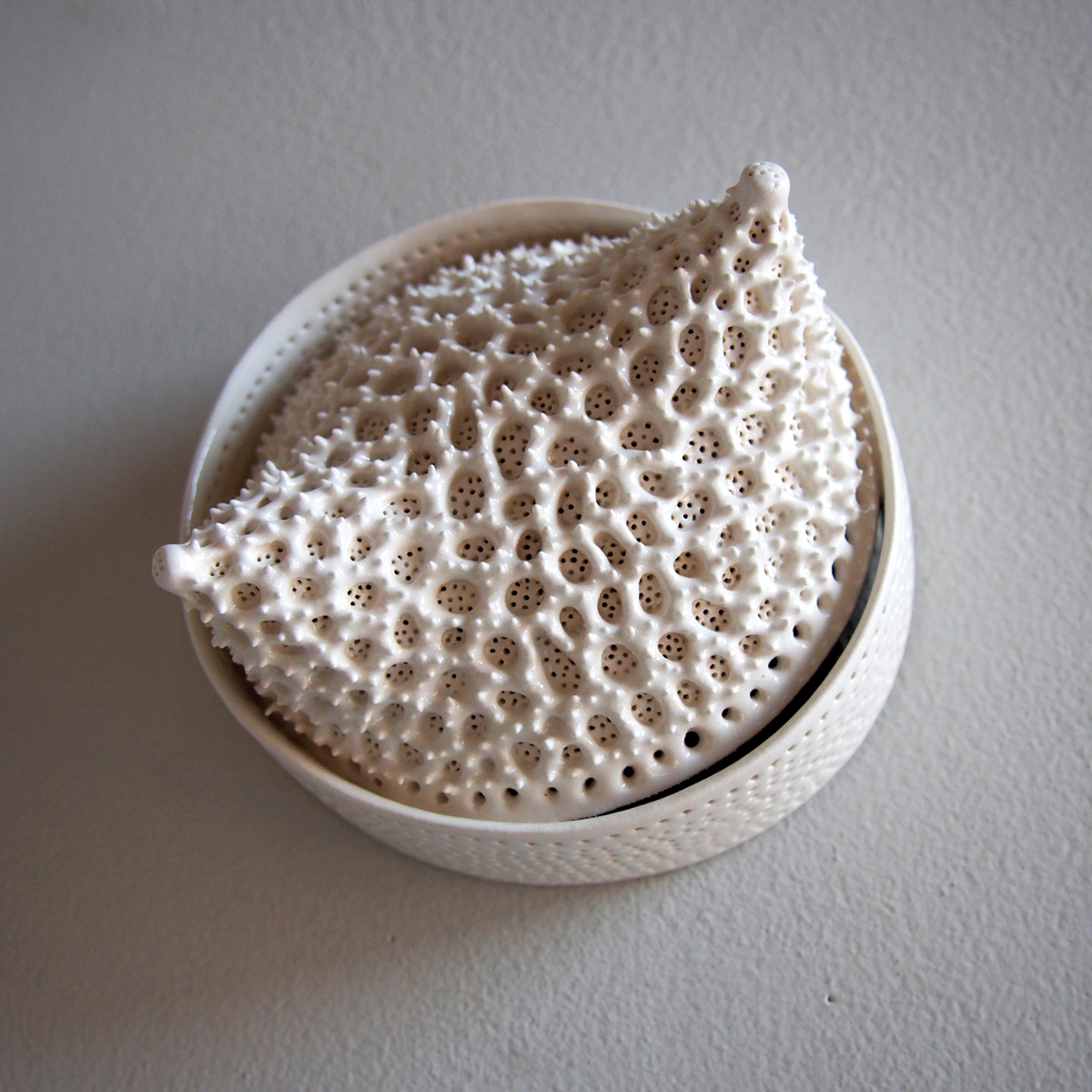
Diatom Odontella Petit Shield
hand-built ceramic, 2.5” x 4.25” x 4”
This cosmopolitan diatom is at home in seas around the world. Apart of a mighty microscopic family it contributes to over 25% of oxygen produced by diatoms alone. Diatoms are one-cell, glass lace housing plankton and have been supporting life on Earth for over 200 million years regardless of national borders, culture, politics, gender or sexual preference. They are a magnificent example of working together for mutual benefit. The charming odontella fuses their “horns” to connect in scintillating spirals, zig-zags and chain colonies forming interdependent communities.
Their micro-scale goes macro when they bloom in spring filling over 10% of the ocean can be seen from satellite video.
Imagine what we can do together.
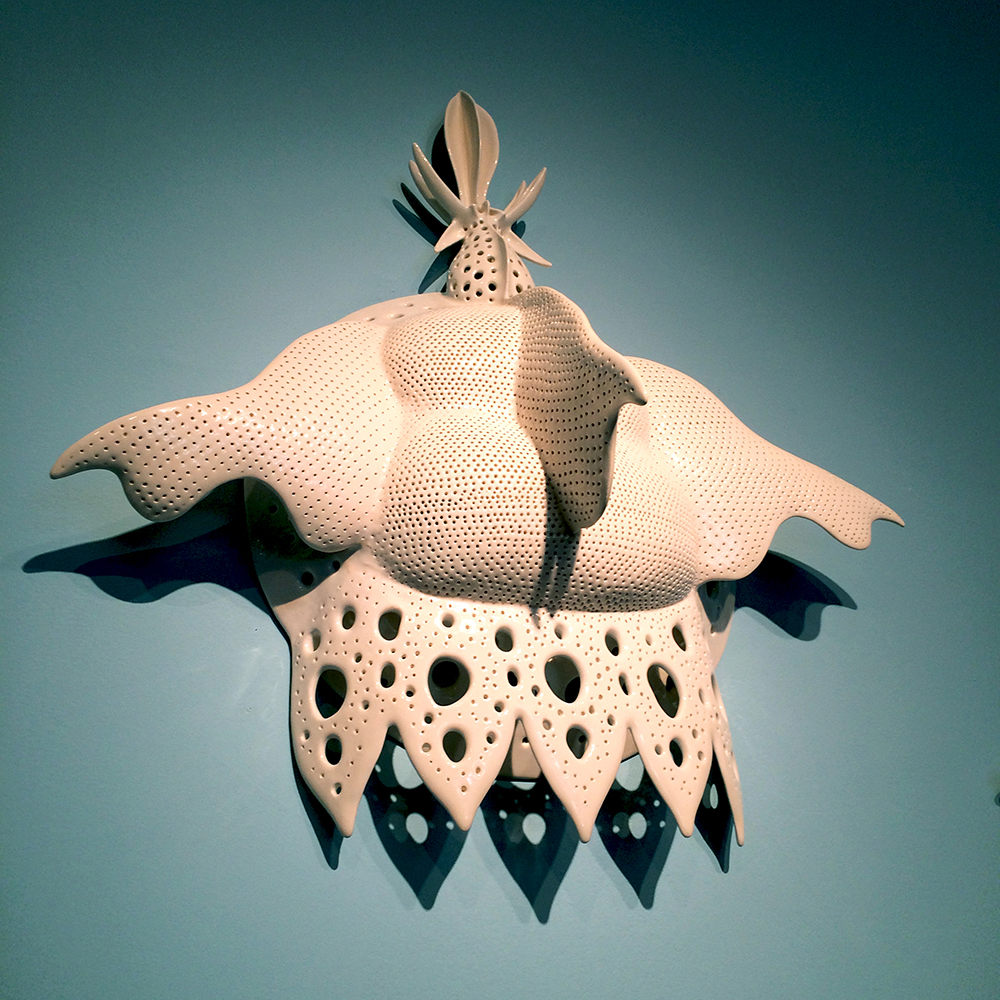
Radiolaria Cyrtoidea 1 Shield
hand-built ceramic, 22” x 24" x 12”
The ceramic shield gives a microscopic glimpse to this exquisite single-cell marine species. Radiolarian produces silica structures of intricate glass architecture. As some of earth's earliest life forms they have been around approximately 540 million years. First named and described by Ernst Haeckel in 1862, Cyrtoidea is by far largest of all orders of Radiolaria with extraordinary diversity of forms.
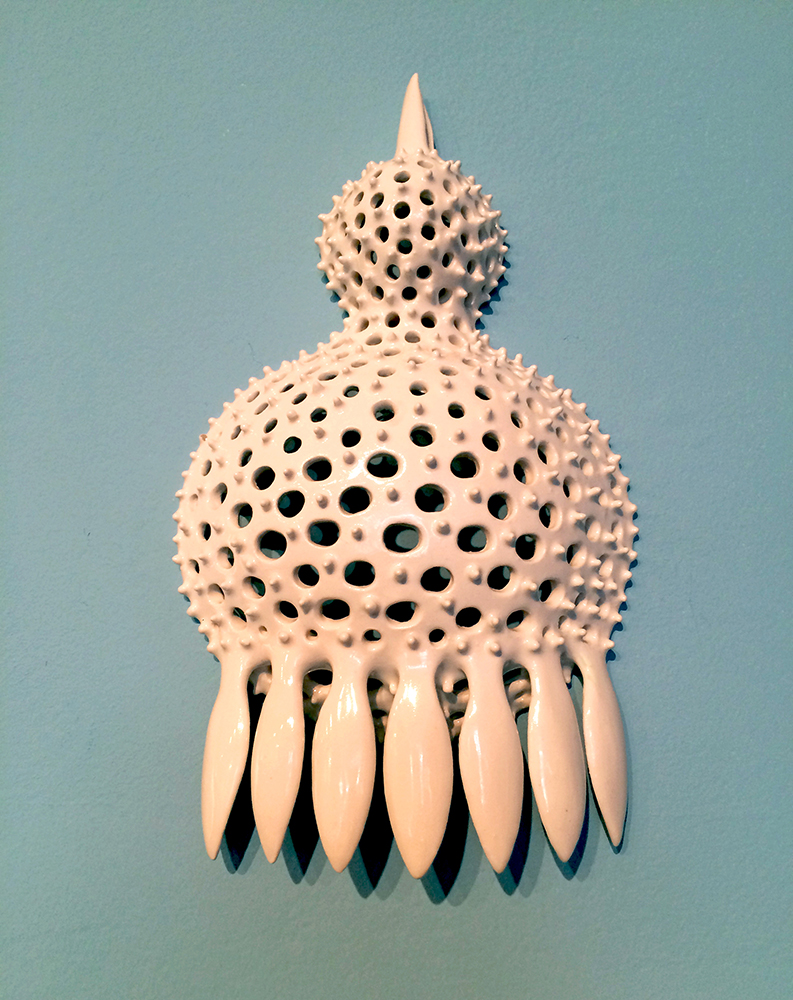
Radiolaria Cyrtoidea 2 Shield
hand-built ceramic, 9.25” x 5.5” x 1.5”
The ceramic shield gives a microscopic glimpse to this exquisite single-cell marine species. Radiolarian produces silica structures of intricate glass architecture. As some of earth's earliest life forms they have been around approximately 540 million years. First named and described by Ernst Haeckel in 1862, Cyrtoidea is by far largest of all orders of Radiolaria with extraordinary diversity of forms.

Radiolaria Cyrtoidea 3 Shield
hand-built ceramic, 16”h x 12.5” x 5.5”
The ceramic shield gives a microscopic glimpse to this exquisite single-cell marine species. Radiolarian produces silica structures of intricate glass architecture. As some of earth's earliest life forms they have been around approximately 540 million years. First named and described by Ernst Haeckel in 1862, Cyrtoidea is by far largest of all orders of Radiolaria with extraordinary diversity of forms.
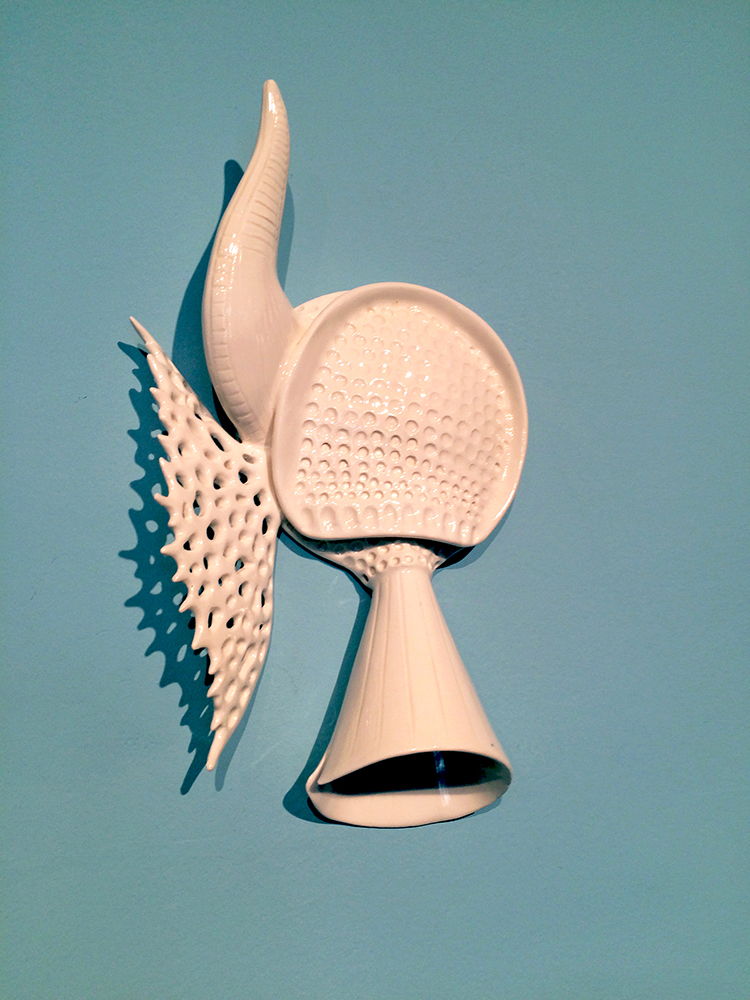
Dinoflagellate Ornithocercus Magnificus Shield
hand-built ceramic, 8.5” x 5” x 2”
Inspired by a drawing of this species by Ernst Haeckel from his infamous book Art Forms in Nature published first in 1899. His drawings are so accurate that in my research I could identify current untitled photos of this species.
More about Dinoflagellates under La Mer Micro Sculpture.
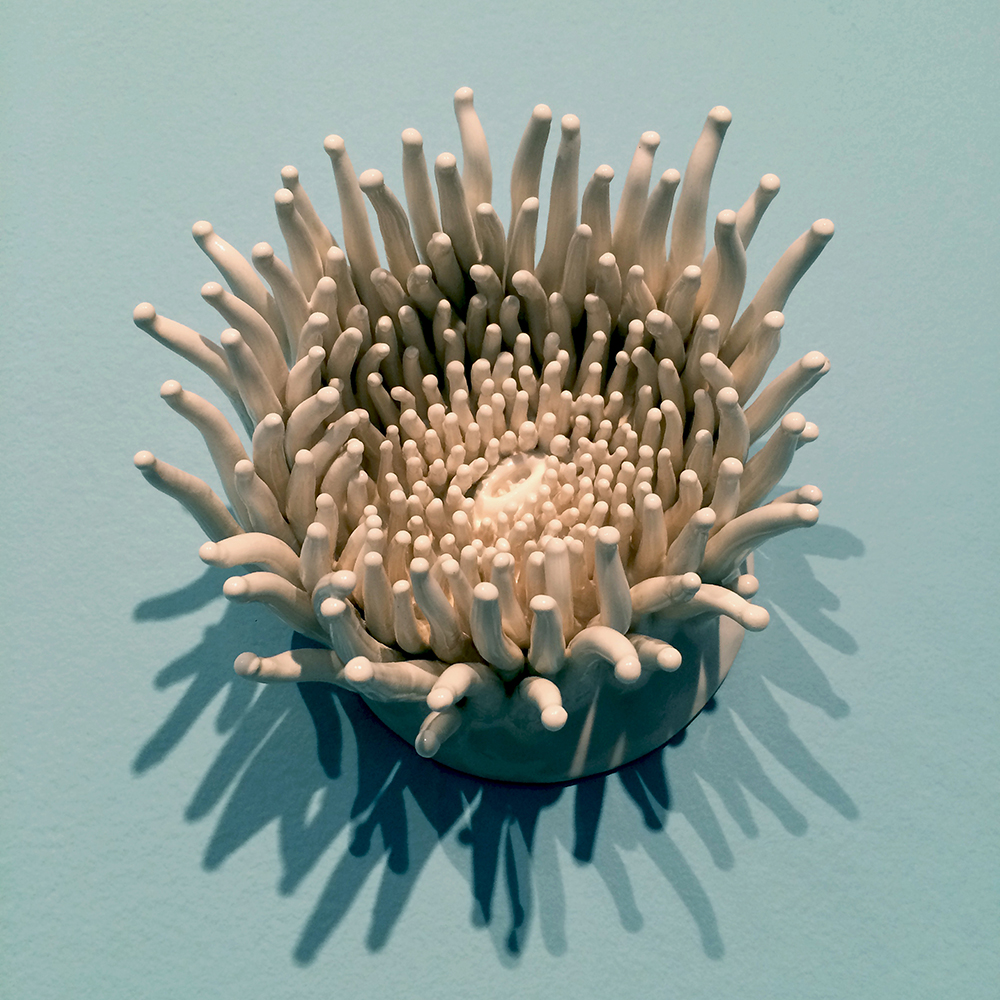
Sea Anemone Shield
hand-built ceramic, 5” x 5” x 3”
Named for the terrestrial flower these ornate predatory animals are relatives to coral and jellyfish. The venom-filled tentacles ensnare prey by firing a harpoon-like filament into victim with paralyzing neurotoxin. They share symbiotic relationship with green algae providing safe harbor in exchange for oxygen, sugar and photosynthesis bi-products. Its infamous symbiotic alliance with the clownfish offers lodgings and meals for clownfish protected from poison in mucous cloaking device.
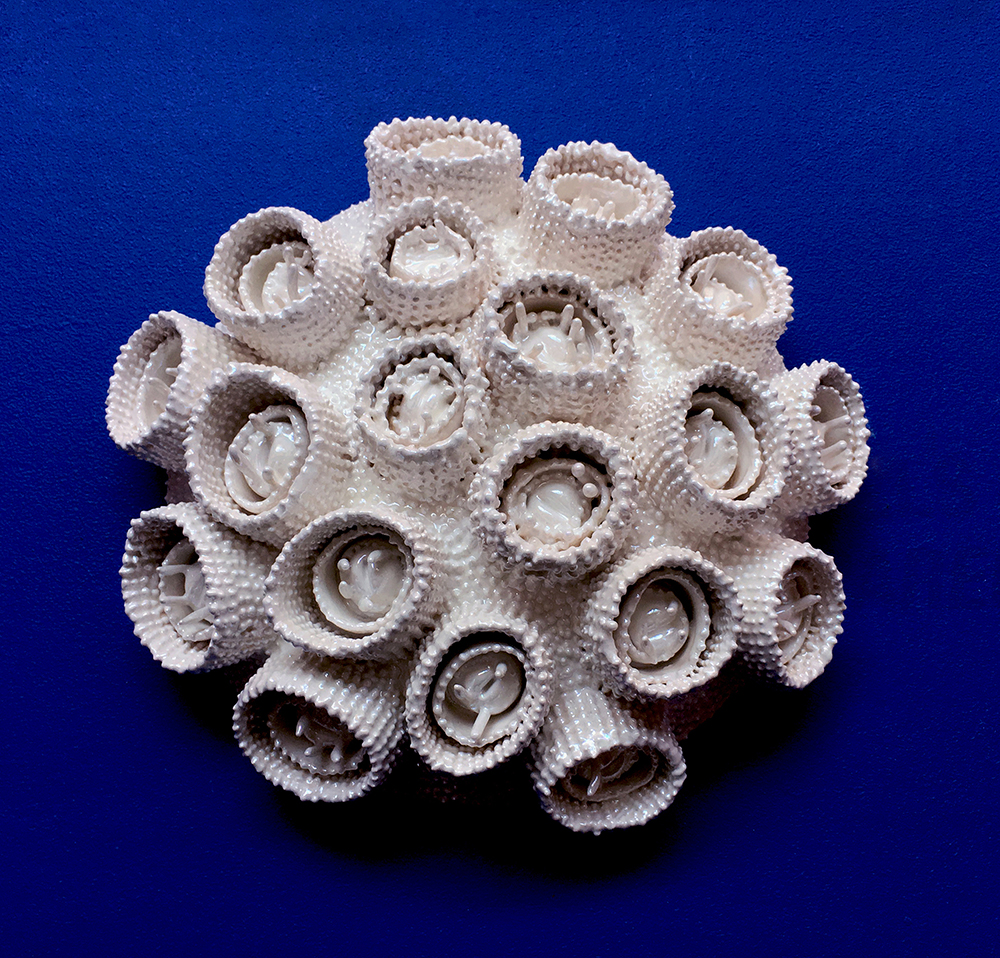
Great Star Coral Shield
hand-built ceramic, 9” x 9.5” x 3”
This beauty is a stony coral colony found in the Caribbean and romantically spawns by the full moon. It forms massive boulders and domes of 5’ in diameter in shallower waters and sometimes plates at greater depths. Corals cover less than 1% of the ocean but are home to over 25% of all marine fish species.
Coral reefs well known for their tremendous biodiversity and beauty are the most complex ecosystems in the sea. They host a massive number of organisms, engineer their own structure and are a habitat for the wealth of other organisms. Corals create their own skeletal armature by excreting calcium carbonate supporting their “village”.
Corals are vital resources for millions of humans in tropical, especially developing countries, who depend on them for fisheries, tourism income, storm protection and sometimes structural materials. Biodiversity of coral reefs is also recognized for its pharmacological potential.
Warm water or shallow coral reefs, home to the Great Star Coral are formed by a highly successful yet environmentally sensitive symbiosis between animals and plants or protists, specifically dinoflagellate (algae) zooxanthellae. The plankton lives inside the tissue of the warm water coral to provide nutrients and photosynthesize producing another essential resource for the environment.
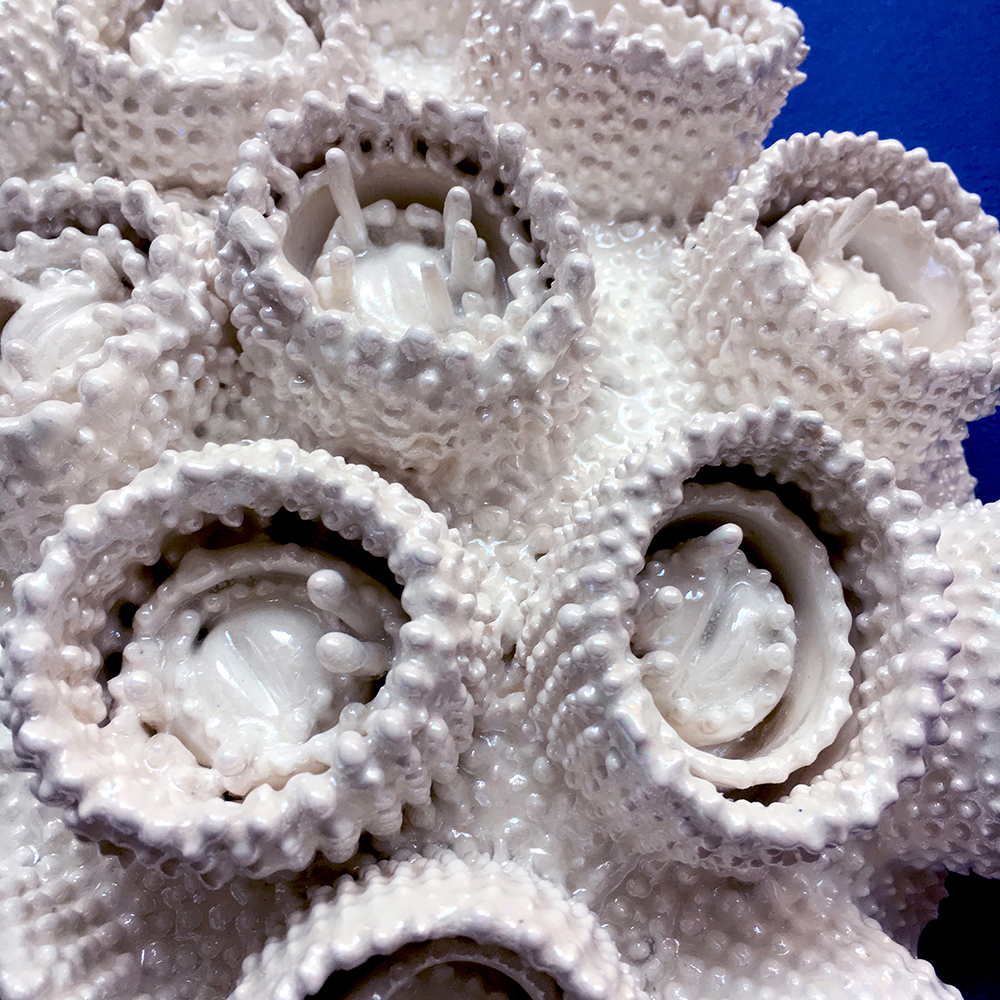
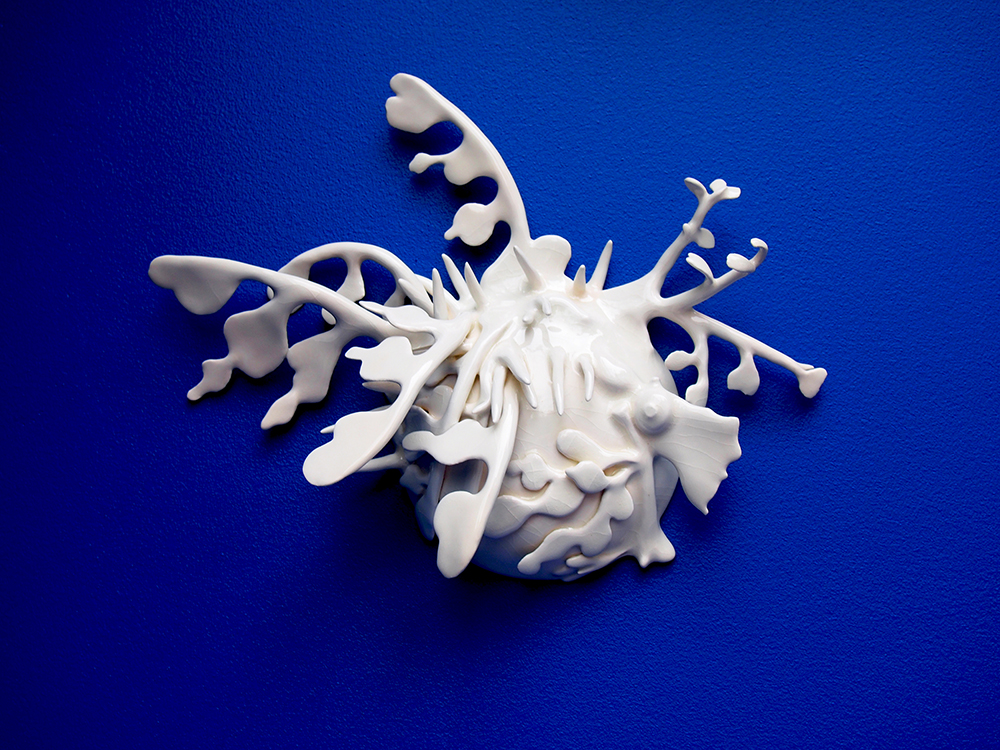
Leafy Sea Dragon Shield
hand-built ceramic, 9” x 12” x 3.75
This swimming garden is one of the most elaborately camouflaged species on earth. This marine fish is in the family Syngnathidae, which also includes pipefish and seahorses and is the only member of the genus Phycodurus.
The Leafies live off the south and east coast of Australia. With no known predator but humans who are damaging their habitat and stealing them for pets. The Leafies’ numbers dropped so drastically that in 1990 the Australian government placed a complete were protected on the species. Like Weedies and Seahorses, the males are responsible for childbearing. Once the female transfers the eggs they fertilize and the male carries the brood of bright pink eggs on their tail until they hatch.
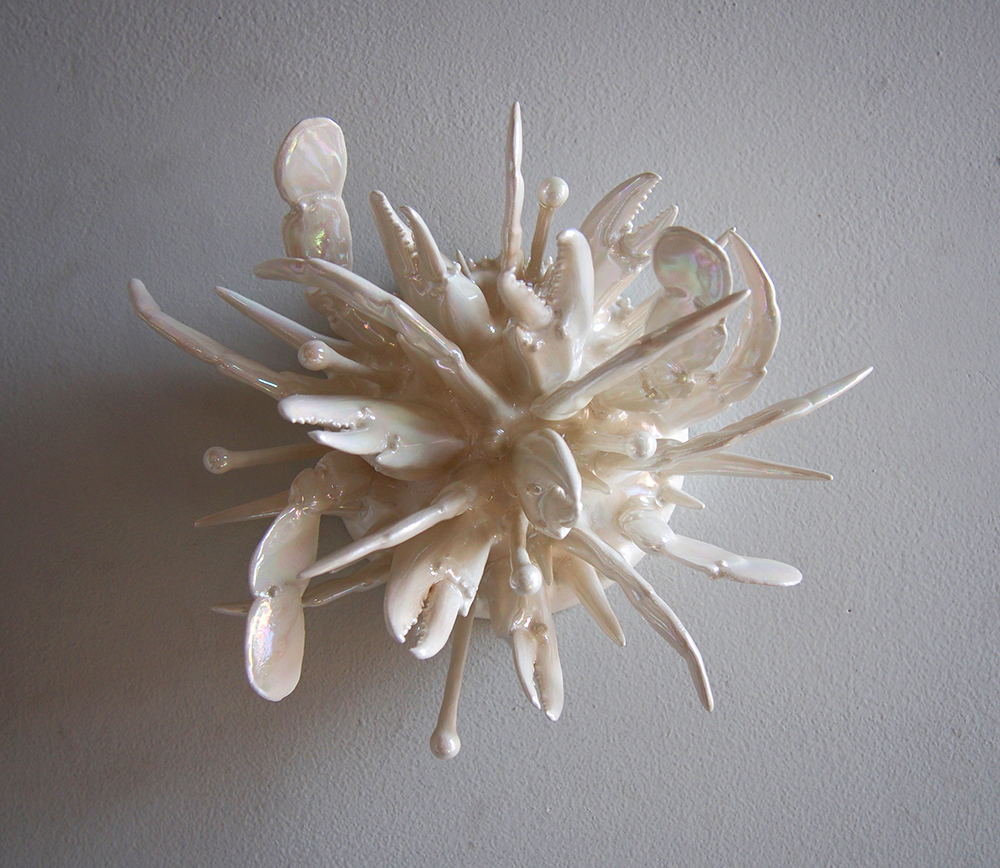
Beautiful Swimmer: Blue Crab, Callinectes Sapidus Shield
hand-built ceramic, 4.25” x 8” x 9”
Beautiful Swimmer from the Latin inhabits Nova Scotia to Argentina in the western Atlantic Ocean. This bottom- dwelling crustacean is a keystone species in the Chesapeake Bay where classically many species are dependent upon it for their own survival. The Chesapeake Bay, the largest estuary in the United States, is an extremely productive and complex ecosystem. The Bay ecosystem consists of the Bay itself, its local rivers and streams, and all the plants and animals it supports. Like any other system, an ecosystem is composed of interrelated parts that interact with each other to form a whole. Every living thing needs a healthy ecosystem to survive.
Human activities affect the Chesapeake Bay ecosystem by adding pollution, using resources and changing the character of the land. However, we can make better choices in our everyday lives to lessen our footprint on the Bay ecosystem’s health and elsewhere. Blue crabs were over fished and dropped to critical levels in the 90’s and have been struggling but making a comeback in recent years. The Blue crab is one of the most important commercial and recreational catches in the Chesapeake Bay. In 2014 the Blue crab catch was worth over $80 million. Protect and sustain the priceless beauty.
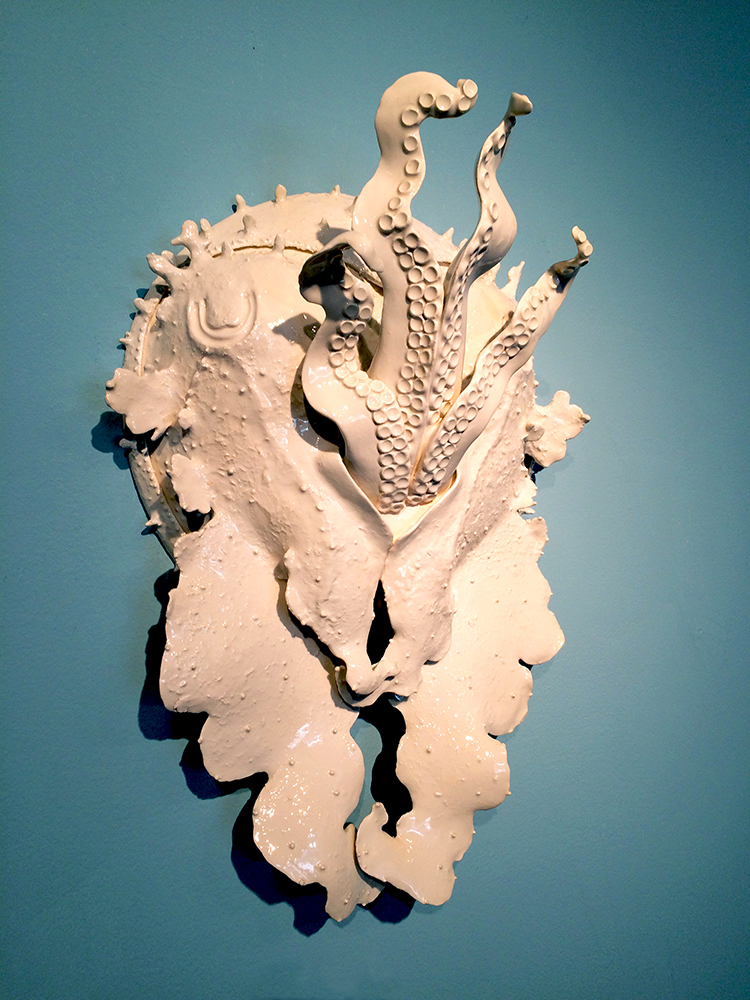
Broad Club Cuttlefish Shield
hand-built ceramic, 22" x 15" x 8”
A cephalopod ultimate shape shifter, color changing technician and yes, cross-dresser. Found around the world but absent in the Americas it has 3 hearts, 8 legs, “W” shaped eyes and the largest brain of any invertebrate.
A master of light shows it has a dual layer lighting system. With 20 million pigment cells in its skins called chromatophores connected in a muscular web that contract and expand to produce moving patterns in color. Beneath the skin are iridescent reflecting cells joining the display in waves throughout out its body that stun its prey. Its sensitive eyes detect light, color and texture in its surroundings. In a flash it shifts from an attention getting smooth performer to vanish camouflaged in raised textured skin responding to its environment. Its tentacles help deflect its presence becoming coral or algae-like appendages. Some males present as females while larger males battle it out and sneak off with the female to mate.
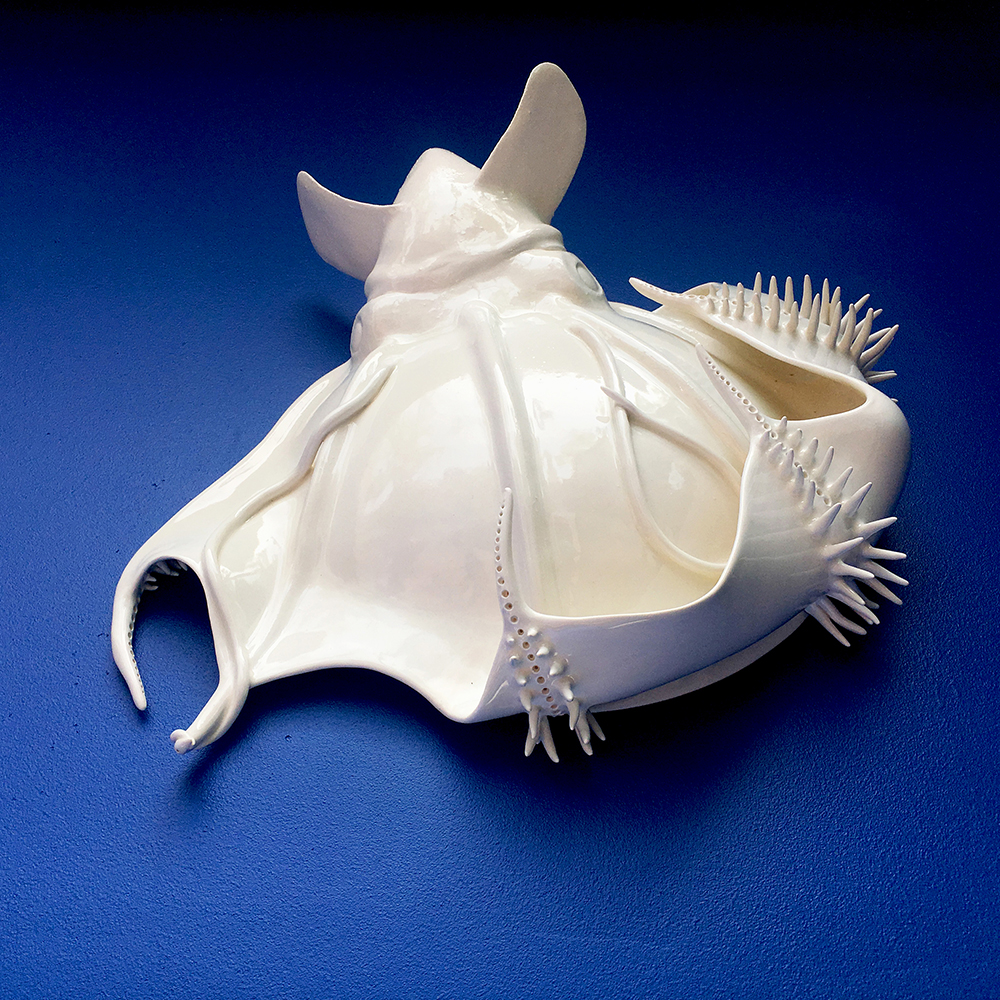
Vampire Squid from Hell Shield
hand-built ceramic, 20” x 22" x 9"
The Vampire Squid from Hell, Vampyroteuthis Infernalis is actually an ancient, gentle creature and ancestor to the squid and octopus. After millions of years, it continues to inhabit the oxygen deprived ocean depths of the Atlantic, Pacific and Indian oceans. Just over 5” long this small cephalopod sports a red hooded cape with large blue eyes and fang-like protective tentacles line its "cape" interior. It has 2 long flagella that reach out to collect its diet of “marine snow”, detritus and decay on a film of mucous which it balls up and eats. In moments of protection the vampire squid turns itself inside out exposing the threatening “fangs” in a strategy called the “pineapple move”.

Manta Ray Shield
hand-built cerami, 21.5” x 34.5” x 10.25”
The manta ray is highly sensitive, social, intelligent and endangered. Championing the largest brain proportionate to its body of any living creature, the area governing intuition is 3x larger proportionate to our own. Offering protection from harm, the shield concept also honors family and lineage including our planet’s species.
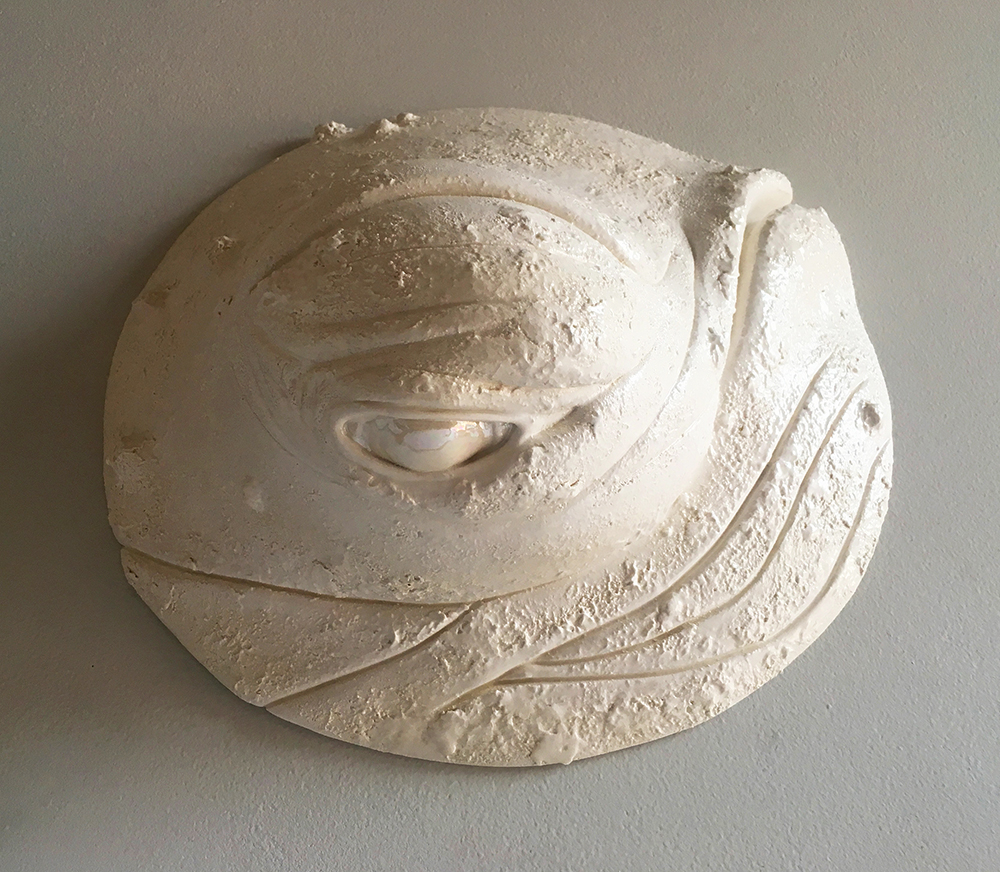
Humpback Whale Shield
hand-built ceramic, 12.25” x 12.5” x 4.5”
Weighing in at about 25-40 tons and between 50’ - 80’ long with natural life spans approximately 50 years, these intelligent giants are cosmopolitan residents of our planet migrating throughout all oceans. They filter about 3,000 pounds of plankton, krill and small fish a day through their baleen to fuel their powerful bodies. Single-cell diatoms are a majority of our largest creature’s diet. Everything is connected. The clusters of bumps around their face actually house a single hair that acts as a sensor.
As the singers of the seas, the humpback males are known for their mythic songs, which can be heard for miles. Since they do not have vocal cords or the ability to breath through their mouths, their music is created through their blowhole. Each whale has his unique song and repeats it again and again and develops different arrangements over time. They sing to each other and collaborate creating impromptu scores.
When a fellow whale is injured or dies, they wail in mourning. The part of their brain governing self-awareness, intuition and emotion is three times larger proportionately than ours. This highly sensitive being not only has profound depth of awareness, it has a high-speed network relaying this information via spindle cells forming a rapid transit throughout its brain. They teach their young by example in highly developed matriarchal and interdependent communities.
A brilliant fishing strategy they team up for is bubble netting. One male circles the school of fish enclosing them in a wall of air, while others sound off scaring the spiral of fish towards the surface. Corralled in a package, the humpbacks open their mouths and inhale the confused prey.
We came close to completely erasing this intelligent, sensitive and still endangered species in less than 100 years of whaling, sound, toxic waste and plastic pollution. By the mid sixties, nearing extinction, they became and still are protected against commercial whaling. It was the recording of their songs in the seventies that helped raise awareness for this incredible creature and initiated their slow recovery, one calf at a time.
Mothers carry their baby for a year before birthing, then nurture and teach them for their first year of life. Humpbacks are performance artists of the whale family with dramatic aerial displays, such as breaching or slapping the surface with their fins, torso and tails. Their flukes or tails are unique like their songs and identify individuals. Their characteristically long pectoral fins are a third of their length and navigate their acrobatic choreography.
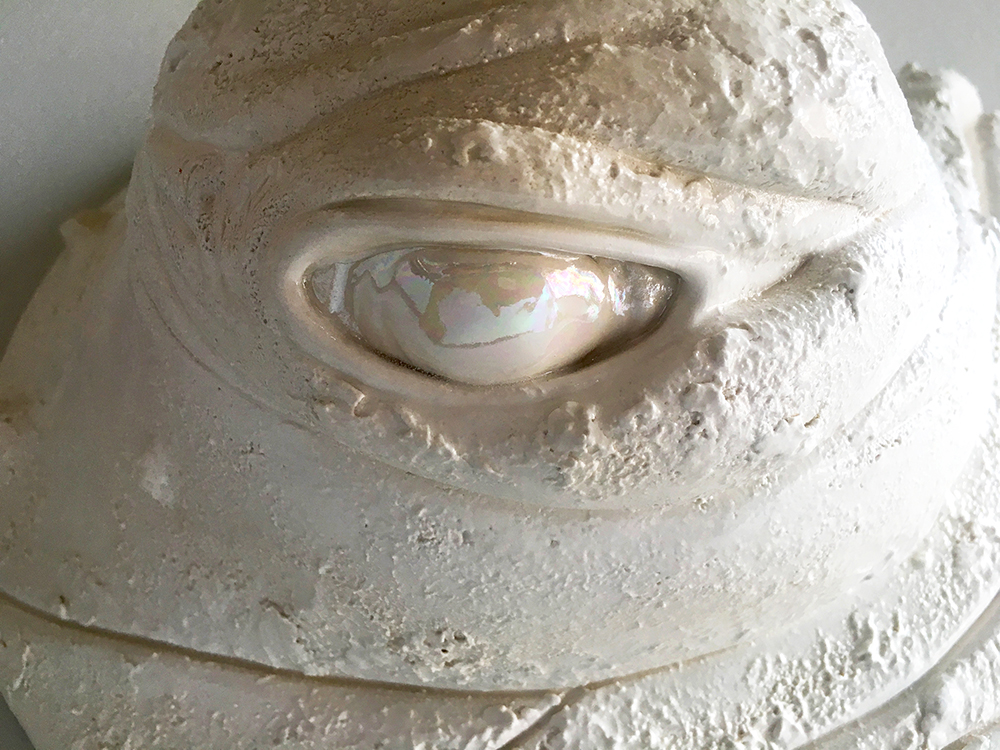
Humpback can protrude their eyes for a closer look as you can see in this shield.